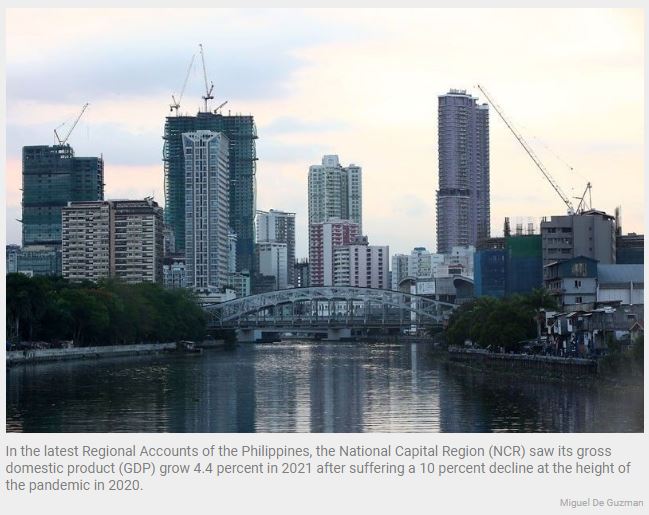Philippines: Crippled by 2021 lockdowns, NCR growth lags among regions
MANILA, Philippines — Metro Manila, epicenter of the pandemic and the country’s major economic hub, managed to recover last year, but its growth remains among the slowest in the Philippines as the region suffered repeated lockdowns and surges in COVID cases.
In the latest Regional Accounts of the Philippines, the National Capital Region (NCR) saw its gross domestic product (GDP) grow 4.4 percent in 2021 after suffering a 10 percent decline at the height of the pandemic in 2020.
Despite the rebound, Metro Manila’s GDP ranked only 15th out of the 17 regions in terms of growth. The NCR’s performance was also lower than the 5.7 percent GDP of the national economy last year.
In nominal terms, Metro Manila’s GDP went up to P5.8 trillion in 2021 from the 2020 level of P5.6 trillion. This is still far from the pre-pandemic level of P6.2 trillion.
Two years into the pandemic, the NCR continues to take a beating from COVID, being the epicenter of the virus, prompting lockdowns and closure of various business establishments.
In a briefing, Philippine Statistics Authority-NCR regional director Paciano Dizon said Metro Manila, which contributes a third to the national economy, had more lockdowns as compared to other regions in the country.
“Lockdowns imposed lasted for almost a month, which contributed to the slow growth of NCR,” Dizon said.
Metro Manila was placed under enhanced community quarantine (ECQ) in April 2021 due to a surge in COVID cases. It was only in mid-May that restrictions were eased.
Unfortunately, the region suffered yet another wave in August last year that prompted the return of ECQ, this time due to the more transmissible Delta variant.
The ECQ was in place until September. Even if the government started the new Alert Level System during the same month, Metro Manila was still under the highest alert level.
“It was only in December that NCR was placed under Alert Level 1 and that added to the slow growth of the region,” PSA assistant national statistician Vivian Ilarina said.
It should be noted that NCR plays a crucial role, especially as the recovery pace of the national economy is dependent on the region.
Moving forward, Ilarina said the government may no longer impose strict lockdowns even amid the presence of the subvariant of Omicron.
“We have started with our second booster shots and hopefully this will continue, which could help in less restrictions,” Ilarina said.
“As we continue to open up the economy, we saw a lot of hotels now opening and we continue to look at the possibility of many tourists coming to NCR. We are projecting that all tourism related activities will pick up after 2021,” she said.
Almost all 16 industry sectors in NCR recovered last year, led by transportation and storage at 10.8 percent.
It was only the accommodation and food service activities that declined at 5.2 percent.
On a per capita basis, the average contribution of an individual to regional GDP grew 3.2 percent to P418,500 per person from P405,700.
Further, the PSA reported that all 17 regional economies recovered last year with Calabarzon registering the biggest increase at 7.6 percent, followed by the Bangsamoro and Cordillera region with 7.5 percent each.
Other regions that grew better than the Philippine economy last year include Central Luzon, Caraga, Northern Mindanao, Eastern and Western Visayas, Davao Region, and Zamboanga Peninsula.
Household spending also went up for all regions, led by Caraga at 10.6 percent.
Source: https://www.philstar.com/business/2022/04/29/2177454/crippled-2021-lockdowns-ncr-growth-lags-among-regions


 English
English




